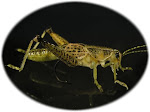The difficulties of tying a Realistic fly go beyond the obvious " how in the world do I re-create that part" to "what materials do I use to make that part". If it's a "one of a kind fly" the material choices are as many as the possible methods for assembling the fly. If instead the fly is to be or represent a "fishable fly" then materials and the techniques must be easily available and the pattern able to be duplicated and taught. Below is a Spider I tyed using only deer hair and thread. It's fishable and easy to tye. The deer hair legs are delicate and don't hold up very well when fished. Although it was easy for the fish to suck the fly in. Replacing the carefully tyed in legs usually meant gluing a new leg on to save the fly for the next outing. These Spiders were sold through Fly shops and catalogs. Originally our price was $5.00 with the retailers mark-up they sold for $10.00. Yes, people bought and fished them.
 Eventually we had to increase the durability of the fly. Deer Hair was exchanged for mono legs and for ease of teaching the abdomen was tyed on the hook. Vickie Eagle Elk tyed the example below from an article in Fly Tyer magazine we did.
Eventually we had to increase the durability of the fly. Deer Hair was exchanged for mono legs and for ease of teaching the abdomen was tyed on the hook. Vickie Eagle Elk tyed the example below from an article in Fly Tyer magazine we did.Although our preference was all natural materials the resulting Realistic Fishable Spider became more durable ,more teachable and still fished well.




